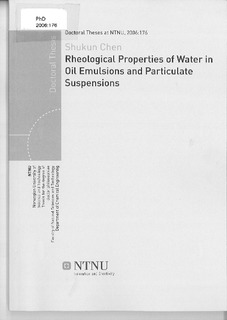| dc.contributor.author | Chen, Shukun | nb_NO |
| dc.date.accessioned | 2014-12-19T13:22:53Z | |
| dc.date.available | 2014-12-19T13:22:53Z | |
| dc.date.created | 2008-05-05 | nb_NO |
| dc.date.issued | 2006 | nb_NO |
| dc.identifier | 124283 | nb_NO |
| dc.identifier.isbn | 82-471-8122-3 | nb_NO |
| dc.identifier.uri | http://hdl.handle.net/11250/248084 | |
| dc.description.abstract | This thesis aims at a better understanding of the rheologicalproperties of the important colloids in oil industry, i.e. suspensions, emulsions and waxes.
The rheology of suspension system is a complex field influenced by a large range of variables. In this work, we mainly focused on the rheological properties of suspensions as a function of volume fraction of particles, particle size, surface properties, shear rate, and the nature of continuous mediums. The investigated suspensions behaved as Newtonian fluids at dilute concentration, whereas, shear thinning properties were observed at high volume fractions. The shear thinning effect increased with decreasing particle size. Ionic strength and pH are both factors affect particle interactions and consequently the rheological properties of suspensions: large and strong aggregates were formed at the isoelectric point, due to the strong attraction between particles at this point. The larger aggregates results in higher viscosity, yield stress, storage moduli and shear thinning effects. The relative viscosity of all the suspensions can be reasonably well fitted with the Krieger and Dougherty model.
Wax precipitation and deposition is a recurring challenge in transportation of crude oil. To better understand and explain these phenomena, the crystal growth of two model waxes was determined as a function of concentration, cooling rate and cooling conditions (static or dynamic). The flow and viscoelastic behaviours were investigated around the wax precipitation temperature, and the yield stress was determined after both dynamic and static cooling. Interpretation of the results was carried out in view of crystal growth and microstructure of the wax crystals.
Rheological properties of wax containing water-in-oil emulsions stabilized by asphathenes were also studied. Temperature scans of viscosity, flow measurements and yield stress measurements were carried out on these systems. The effects of water cut, amount of asphaltenes and amount of waxes were investigated. Wax content and water cut have the most pronounced effect upon the viscosity and yield stress of the systems. | nb_NO |
| dc.language | eng | nb_NO |
| dc.publisher | Fakultet for naturvitenskap og teknologi | nb_NO |
| dc.relation.ispartofseries | Doktoravhandlinger ved NTNU, 1503-8181; 2006:176 | nb_NO |
| dc.relation.haspart | Chen, Shukun; Øye, Gisle; Sjöblom, Johan. Rheological Properties of Aqueous Silica Particle Suspensions. Journal of Dispersion Science and Technology. 26(4): 495-501, 2005. | nb_NO |
| dc.relation.haspart | Chen, Shukun; Øye, Gisle; Sjöblom, Johan. Rheological Properties of Silica Particle Suspensions in Mineral Oil. Journal of Dispersion Science and Technology. 26(6): 791-798, 2005. | nb_NO |
| dc.relation.haspart | Chen, Shukun; Øye, Gisle; Sjöblom, Johan. Effect of pH and Salt on Rheological Properties of Aerosil Suspensions. Journal of Dispersion Science and Technology. 28(6): 845-853, 2007. | nb_NO |
| dc.relation.haspart | Chen, Shukun; Øye, Gisle; Sjöblom, Johan. Rheological Properties of Model and Crude Oil Systems when Wax Precipitate under Quiescent and Flowing Conditions. Journal of Dispersion Science and Technology. 28(7): 1020-1029, 2007. | nb_NO |
| dc.title | Rheological Properties of Oil in Water Emulsions and Particulate Suspensions | nb_NO |
| dc.type | Doctoral thesis | nb_NO |
| dc.contributor.department | Norges teknisk-naturvitenskapelige universitet, Fakultet for naturvitenskap og teknologi, Institutt for kjemisk prosessteknologi | nb_NO |
| dc.description.degree | PhD i kjemisk prosessteknologi | nb_NO |
| dc.description.degree | PhD in Chemical Process Engineering | en_GB |
